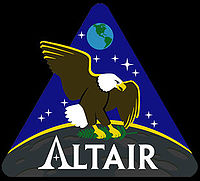Altair (Lunar Module)
| Altair Lunar Module | ||
|---|---|---|
 |
||
| description | ||
| Use: | Lunar orbit / surface | |
| Crew: | 4 people | |
| Status: | Concept phase (development stopped) | |
| Operation area: | global landing ability on the moon | |
| Dimensions | ||
| Height: | 9.9 m | |
| Diameter: | 8.8 m | |
| Volume under pressure: | 17.5 m³ | |
| Crowds | ||
| Ascent module: | 6,141 kg | |
| Landing module: | 37,045 kg | |
| Total: | 43,186 kg | |
| Engines | ||
| Ascent module ( MMH - NTO ) | 24.5 kN | |
| Landing module ( LOX / LH2 ) | 83 kN | |
| Altair Lunar Module on the Moon (computer graphic) | ||

|
||
The Altair lunar module (formerly Lunar Surface Access Module (LSAM) ) is the lunar module planned by NASA in the Constellation program. This should transport people and equipment to set up a station (by 2020) to the moon . After the cancellation of the Constellation program, the continuation of the concept study is uncertain.
The LSAM was christened Altair in December 2007 . This naming is a homage to the first moon landing, the moon landing module of which was called "Eagle". Altair is the brightest star in the Eagle constellation .
description
Altair
The design of the Altair lander was selected or combined from around 100 concept studies. Despite the many studies, the concepts have a similar structure to the Apollo landing module due to space physics. Most concepts consist of two parts: a descent stage, which contains a large part of the fuel , oxygen and power supply, and an ascent stage, which transports the astronauts, the life support systems and the fuel for the ascent and the steering jets. In contrast to the Apollo landing module , four instead of two astronauts can carry out a lunar mission in the Altair, while the Orion spacecraft remains unmanned in lunar orbit. The LSAM should also be able to be flown unmanned and transport up to 14.5 metric tons of payload to the moon.
The Altair lunar module has two hatches: one for docking maneuvers in space and another for leaving the module on the lunar surface. The main hatch has an air lock so that no moon dust is dragged into the ferry and the module can remain under normal pressure when a crew member puts on a spacesuit. The landing unit also includes a toilet that is already used in the Soyuz spaceships and the ISS , a food warmer, a laser range finder, an altitude radar and a " glass cockpit " that is also used in the Orion spaceship .
Constellation configuration
The lunar module with an Ares V - rocket and the Earth Departure Stage launched into orbit around there with that of an Ares-I rocket into space carried spaceship Orion perform a docking. The entire entourage then flies from the Earth Departure Stage to the moon . After the transfer maneuver to the moon, the Earth Departure Stage will be separated. After three days, Orion and Altair enter a lunar orbit using the Altair landing module engines. For the 2.5-hour landing phase, the cast members transfer to the lander and separate Altair from Orion. The landing unit and the four crew members either remain on the moon for seven days or in the presence of a lunar base for up to 210 days. For the return, the ascent module separates from the landing module and flies in the direction of the transport spaceship Orion for the return coupling maneuver. Before the Orion module is fired back, the Altair ascent module is disconnected from Orion. After Orion has entered the earth's atmosphere and the Orion lander has decelerated, it glides back to earth by means of parachutes.
The era from President Obama
Due to President Obama's announcement at the beginning of 2010 that he would no longer support the Constellation program , the continuation of the Altair concept is uncertain. Perhaps one day the concept will be used for the new plans to land on an asteroid by 2025.
Picture gallery
Web links
- Space Review
- Global security
- T. Polsgrove, R. Button, D. Linne: Altair Lunar Lander Consumables Management. (PDF; 3.7 MB) NASA , October 28, 2009, accessed on April 16, 2011 (English).
- Review of US Human Spaceflight Plans Committee - Seeking a Human Spaceflight Program Worthy of a Great Nation. (PDF; 8.0 MB) US Human Spaceflight Plans Committee, October 22, 2009, accessed April 3, 2011 .
- Clinton Dorris: Lunar Program Industry Briefing - Altair Overview (presentation). (PDF; 1.4 MB) NASA / Altair Project Office, September 25, 2008, accessed on April 16, 2011 (English).
Individual evidence
- ↑ a b c d e f Constellation Program: America's Spacecraft for a New Generation of Explorers - The Altair Lunar Lander. (PDF; 1.8 MB) Lyndon B. Johnson Space Center / NASA , October 2, 2008, accessed April 3, 2011 .
- ↑ NASA Names Next Generation Moon Lander 'Altair'. NASA , October 17, 2008, accessed April 16, 2011 .





